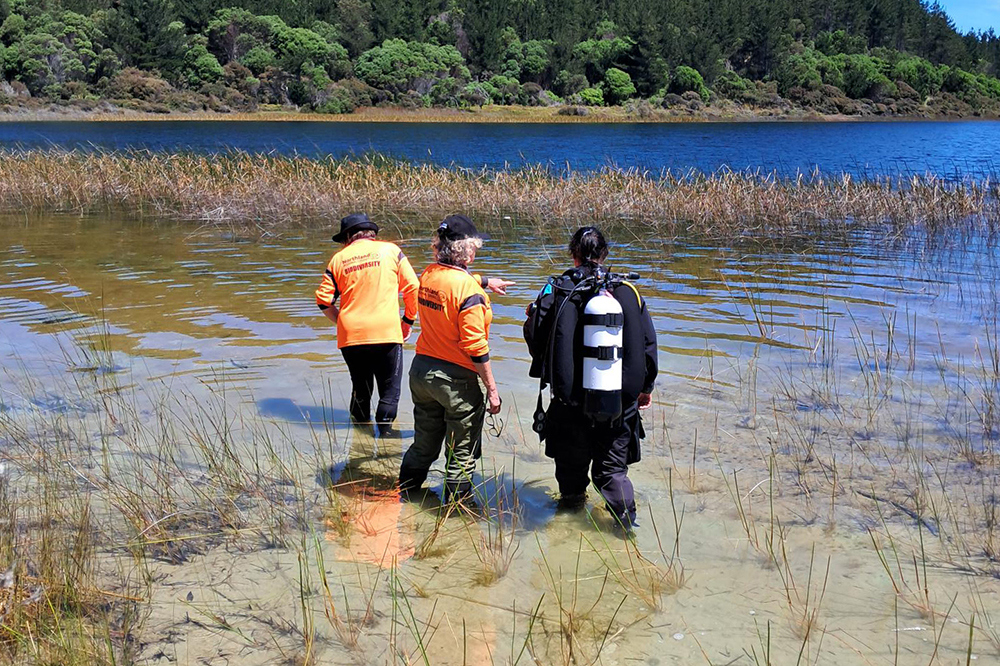Story
Good news after Kai Iwi dive survey
A recent dive survey of the Kai Iwi Lakes has found no trace of four serious aquatic weeds, a positive result for these nationally significant lakes. However, the public is being warned against complacency as the risk of these weeds and a new potential freshwater invader, the gold clam remains.
The survey of all three Kai Iwi lakes – among the best dune lakes on the planet – was undertaken by Northland Regional Council divers looking for hornwort and three oxygen weeds; lagarosiphon, egeria, and elodea.
Jack Craw, who chairs the council’s Biosecurity and Biodiversity Working Party, says weed surveillance has been carried out in the lakes for more than 20 years but this is the first year council has had the in-house capability to undertake the surveillance itself.
Councillor Craw says the survey result is great news for the lakes, which have good water quality and are the least impacted of New Zealand lowland lakes.
All four weeds are found in other lakes and rivers in Northland and also in popular water-skiing lakes further south. They can be spread by tiny fragments attached to water equipment, trailers and on boats in places like anchor wells and bilges.
Despite the recent clean bill of health on the pest plant front, Cr Craw warns against complacency.
“If any of them became established in Kai Iwi lakes they could spread quickly and have a massive impact, ruining the lakes for recreational use, so it is important to keep a close eye out for these weeds.” He says if any of these weeds are found a programme will be put in place with the aim of eradicating them before they spread out of control.
Councillor Craw says it’s important for all lake users to follow the ‘Check, Clean, Dry’ process when moving boats and equipment between waterways, to keep an eye out for pest weeds and inform the NRC if they see anything that doesn’t look right.

Pictured during the recent Kai Iwi Lakes dive survey are NRC staff from left, Jacki Byrd (Biodiversity Specialist – Freshwater) Lisa Forester (Biodiversity Manager) and Monica Nevill-Jackson (Biosecurity Officer – Marine).
Meanwhile, he says the NRC (which has biosecurity responsibilities) and Kaipara District Council (which manages the lakes’ campgrounds and maintains Taharoa Domain) are working with Te Roroa iwi and Te Kuihi hapū to prevent the gold clam from reaching and potentially devastating the lakes. “The public has its own role to play in that regard.”
Councillor Craw says normal ‘Check, Clean, Dry’ methods don’t work for the clam, which can survive for up to 10 days out of water. Kayaks and boats - especially wake boats with their internal ballast tanks - are the highest risk of spreading the clam.
He says it’s hard, if not impossible, to fully empty and dry boat ballast tanks, which means the clam can survive between boating sites.
"Best practice is to use a high-pressure steam cleaner or a power wash on to grass or gravel where there is no likelihood of runoff entering back into a waterway or stormwater system."
"For absorbent materials, such as lifejackets or waders, they must be frozen overnight, soaked in for 30 minutes in 10 percent bleach solution, or washed in hot water (45C degrees plus) for 20 minutes." To see the full set of treatment options see Gold Clam Treatment Options at mpi.govt.nz
Councillor Craw says a single clam can produce 400 juveniles a day under favourable conditions and has never been eradicated from an invaded location before. The clams are already being reported at a density of hundreds of individuals per square metre in the Waikato, and at highly-infested sites overseas that density can reach up to 20,000 clams per square metre.
Further information about gold clams is available from: www.biosecurity.govt.nz/freshwaterclams
